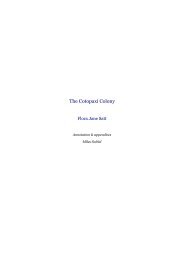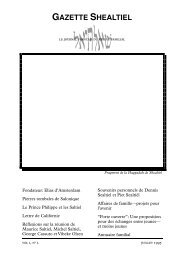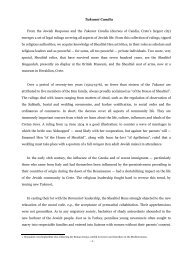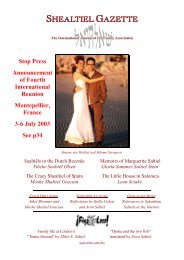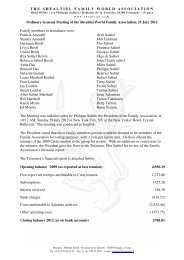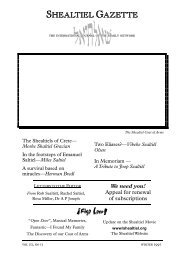Gazette Vol 1 No 4 - The Shealtiel Family Worldwide
Gazette Vol 1 No 4 - The Shealtiel Family Worldwide
Gazette Vol 1 No 4 - The Shealtiel Family Worldwide
Create successful ePaper yourself
Turn your PDF publications into a flip-book with our unique Google optimized e-Paper software.
december 1995 SHEALTIEL GAZETTE vol i no iv<br />
Figo Loco: the Synagogue of the <strong>Shealtiel</strong>s<br />
For over four centuries the <strong>Shealtiel</strong>s of Salonika were the exclusive worshippers<br />
at the synagogue known as “Figo Loco”. Moshe Shaltiel tells its story and<br />
how its name— Crazy Fig— came to characterise its fiery congregants<br />
Almost every <strong>Shealtiel</strong> of more than fifty years<br />
of age has heard the expression or idiom “Figo<br />
Loco”. My research on this score is far from<br />
complete, but I want to commit to print what I<br />
have gathered to date, rather then to rely upon<br />
memory for the details I have learned. My<br />
other purpose is to encourage members of the<br />
family to share with me information I have<br />
missed.<br />
”<br />
<strong>Shealtiel</strong> family 1 .<br />
Typical of the bizarre sense of humour of Salonica's<br />
Jewish community, the <strong>Shealtiel</strong>’s most<br />
visible or more actually, audible, characteristic—<br />
hot temper and the tendency to express<br />
themselves loudly— became the new interpretation<br />
for Figo Loco. It was said that the <strong>Shealtiel</strong>s<br />
have two branches the Macaroni, or those<br />
who came to Salonica via Italy; and the Locos,<br />
the crazy ones.<br />
One theory of the origin of the phrase is that<br />
the roots of Figo Loco are in Barcelona, where<br />
it was a noble title or a coat of arms,—<br />
depicting a wild Fig tree of the <strong>Shealtiel</strong> <strong>Family</strong>.<br />
Another is that the name Figo Loco was a<br />
simple reference to a wild fig that grew in the<br />
yard of the synagogue Catalan Hadash which<br />
was considered the <strong>Shealtiel</strong>’s synagogue. We<br />
have found no documentary evidence found to<br />
date to confirms or trace the Figo Loco to Barcelona.<br />
Gila and I are planning a trip to Barcelona<br />
to research that subject.<br />
When the family settled in Salonica around<br />
1492, (there is a possibility that the family arrived<br />
in Salonica earlier) its members, along<br />
with their fellows Barcelonans, built a synagogue,<br />
named K.K Catalan. In 1510 the <strong>Shealtiel</strong><br />
family spun off and established their own<br />
Kehila but under the influence of Rabbi Elazar<br />
Shimoni rejoin their old congregation. In 1570<br />
the family left for the final time and established<br />
their own synagogue K.K. Catalan Hadash,<br />
“<strong>The</strong> New Catalan” and kept their commitment<br />
to it for hundreds of years. <strong>The</strong> new<br />
synagogue was also known as Le Kehila De Figo<br />
Loco.<br />
<strong>The</strong> first Machzor (prayer book) printed in Salonica<br />
was brought from Barcelona by the congregants<br />
of K.K Catalan. It was printed in 1528<br />
by Don Yehudah Ben Gedaliah and Sons. <strong>The</strong><br />
cover of the only known complete book, at<br />
Yad Ben Zvi institute in Jerusalem, has the<br />
name of Yoseph <strong>Shealtiel</strong> on. Figo Loco was<br />
destroyed in the 1917 fire and was never<br />
rebuilt. But in 1927, although Figo Loco no<br />
longer existed, a new edition of the Machzo<br />
was printed and was again credited to the<br />
page nine<br />
”<br />
Figo Loco also became an expression to say<br />
something that happens long time ago, thus<br />
Tiempo De Figo Loco. When Albert Saltiel, a<br />
ninetyfive yearold resident of Seattle wished<br />
to express his displeasure that we were late for<br />
our meeting with him, he said that we were<br />
supposed to be there at the Tiempo de Figo<br />
Loco<br />
Some other anecdotes:<br />
• Elvira Ben AsherShaltiel from Tel Aviv recalls<br />
her father’s stories about the noble title<br />
granted to the family in Barcelona,<br />
Spain. She also remembers that years ago,<br />
when she called Nico Malach loco in humour,<br />
he responded that she, as a <strong>Shealtiel</strong>,<br />
is loco since the <strong>Shealtiel</strong> family are todos<br />
locos— all mad. Of course Nico himself was<br />
a <strong>Shealtiel</strong> through his maternal Grandmother.<br />
• My father, Daniel, told me that he remembers<br />
a cousin of his father, Leon Amaragi,<br />
calling his son El Figo Loco. Daniel says that<br />
it did not sound like a compliment!<br />
• Aaron Shaltiel, in telephone conversation<br />
from Austria, told me that his grandmother,<br />
the wife of Aaron <strong>Shealtiel</strong> (a Grandson of<br />
Han Bechor <strong>Shealtiel</strong>) used to joke that the<br />
outbursts of her husband were his Figo Loco<br />
heritage. Aaron always thought it was a<br />
name of a place were the <strong>Shealtiel</strong>s lived,<br />
like a quarter. He heard the name again in<br />
Salonica, he thinks from a David Saltiel,<br />
who also taught him some old Sephardi<br />
melodies. Aaron was referred to David<br />
Saltiel by Victoria Benuzilio, director of the



